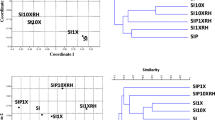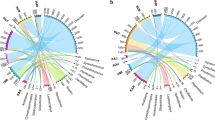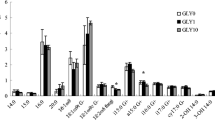Abstract
Despite the intensive use of glyphosate (GP) and its ubiquitous presence in the environment, studies addressing the presence of microbial genes involved in glyphosate degradation in natural conditions are scarce. Based on the agronomical importance of Bradyrhizobium genus and its metabolic versatility, we tested the hypothesis that species or genotypes of Bradyrhizobium could be a proxy for GP degrader potential in soil. A quantitative PCR assay was designed to target a specific region of the glycine oxidase gene (thiO), involved in the oxidation of glyphosate to AMPA, from known sequences of Bradyrhizobium species. The abundance of the thiO gene was determined in response to herbicide application in soils with different GP exposure history both under field and microcosm conditions. The gene coding for RNA polymerase subunitB (rpoB) was used as a reference for the abundance of total Bradyrhizobia. The assay using the designed primers was linear over a very large concentration range of the target and showed high efficiency and specificity. In a field experiment, there was a differential response related to the history of glyphosate use and the native Bradyrhizobium genotypes. In a soil without previous exposure to herbicides, thiO gene increased over time after glyphosate application with most genotypes belonging to the B. jicamae and B. elkanni supergroups. Conversely, in an agricultural soil with more than 10 years of continuous glyphosate application, the abundance of thiO gene decreased and most genotypes belonged to B. japonicum supergroup. In a microcosm assay, the amount of herbicide degraded after a single application was positively correlated to the number of thiO copies in different agricultural soils from the Pampean Region. Our results suggest that Bradyrhizobium species are differently involved in glyphosate degradation, denoting the existence of metabolically versatile microorganisms which can be explored for sustainable agriculture practices. The relationship between the abundance of thiO gene and the GP degraded in soil point to the use of thiO gene as a proxy for GP degradation in soil.


Similar content being viewed by others
Data Availability
The authors of this work declare that all data and materials as well as software applications used support their published results. The data are either deposited in public genomic databases or presented in the main manuscript.
References
Myers JP, Antoniou MN, Blumberg B, Carroll L, Colborn T, Everett LG, Hansen M, Landrigan PJ, Lanphear BP, Mesnage R, Vandenberg LN, vom Saal FS, Welshons WV, Benbrook CM (2016) Concerns over use of glyphosate-based herbicides and risks associated with exposures: a consensus statement. Environ Health 15:19. https://doi.org/10.1186/s12940-016-0117-0
Singh S, Kumar V, Gill JPK, Datta S, Singh S, Dhaka V, Kapoor D, Wani AB, Dhanjal DS, Kumar M, Harikumar SL, Singh J (2020) Herbicide glyphosate: toxicity and microbial degradation. Int J Environ Res Public Health 17:7519. https://doi.org/10.3390/ijerph17207519
Zhan H, Feng Y, Fan X, Chen S (2018) Recent advances in glyphosate biodegradation. Appl Microbiol Biot 102:5033–5043. https://doi.org/10.1007/s00253-018-9035-0
Hove-Jensen B, Zechel DL, Jochimsen B (2014) Utilization of glyphosate as phosphate source: Biochemistry and genetics of bacterial carbon phosphorus lyase. Microbiol Mol Biol R 78:176–197. https://doi.org/10.1128/MMBR.00040-13
Sviridov AV, Shushkova TV, Ermakova IT, Ivanova EV, Epiktetov DO, Leontievsky AA (2015) Microbial degradation of glyphosate herbicides. Appl Biochem Microbiol 51:188–195. https://doi.org/10.1134/S0003683815020209
Shames SL, Wackett LP, LaBarge MS, Kuczkowski RL, Walsh CT (1987) Fragmentative and stereochemical isomerization probes for hemolytic carbon to phosphorus bond scission catalyzed by bacterial carbon-phosphorus lyase. Bioorg Chem 15:366–373. https://doi.org/10.1016/0045-2068(87)90033-2
Levering PR, Dijkhuizen L, Harder W (1984) Metabolic regulation in the facultative methylotroph Arthrobacter P1. Growth on primary amines as carbon and energy sources. Arch Microbiol 139:188e195. https://doi.org/10.1007/BF00401998
Bhatt P, Joshi T, Bhatt K, Zhang W, Huang Y, Chen S (2021) Binding interaction of glyphosate with glyphosate oxidoreductase and C–P lyase: molecular docking and molecular dynamics simulation studies. J Hazard Mater 409:124927. https://doi.org/10.1016/j.jhazmat.2020.124927
Shushkova TV, Vinokurova NG, Baskunov BP, Zelenkova NF, Sviridov AV, Ermakova IT, Leontievsky AA (2016) Glyphosate acetylation as a specific trait of Achromobacter sp. Kg 16 physiology. Appl Microbiol Biotechnol 100:847–855. https://doi.org/10.1007/s00253-015-7084-1
Iyer R, Iken B, Damania A, Krieger J (2018) Whole genome analysis of six organophosphate-degrading rhizobacteria reveals putative agrochemical degradation enzymes with broad substrate specificity. Environ Sci Pollut Res 25:13660–13675. https://doi.org/10.1007/s11356-018-1435-2
Huntscha S, Stravs MA, Bühlmann A, Ahrens AH, Frey JE, Pomati F, Hollender J, Buerge IJ, Balmer ME, Poiger T (2018) Seasonal dynamics of glyphosate and AMPA in Lake Greifensee: Rapid microbial degradation in the Epilimnion during summer. Environ Sci Technol 52:4641–4649. https://doi.org/10.1021/acs.est.8b00314
Chen CM, Ye QZ, Zhu ZM, Wanner BL, Walsh CT (1990) Molecular biology of carbon phosphorus bond cleavage. Cloning and sequencing of the phn (psiD) genes involved in alkylphosphonate uptake and C–P lyase activity in Escherichia coli B. J Biol Chem 265:4461–4471
Hove-Jensen B, Rosenkrantz TJ, Zechel DL, Willemoës M (2010) Accumulation of intermediates of the carbon-phosphorus lyase pathway for phosphonate degradation in phn mutants of Escherichia coli. J Bacteriol 192:370–374. https://doi.org/10.1128/JB.01131-09
Kertesz M, Elgorriaga A, Amrhein N (1991) Evidence for two distinct phosphonate-degrading enzymes (C–P lyases) in Arthrobacter sp. GLP-1. Biodegradation 2:53–59. https://doi.org/10.1007/BF00122425
Bazot S, Lebeau T (2008) Simultaneous mineralization of glyphosate and diuron by a consortium of three bacteria as free- and/or immobilized-cells formulations. Appl Microbiol Biotechnol 77:1351–1358. https://doi.org/10.1007/s00253-007-1259-3
Jacob GS, Garbow JR, Hallas LE, Kimack NM, Kishore GM, Schaefer J (1988) Metabolism of glyphosate in Pseudomonas sp. strain LBr. App Environ Microbiol 54:2953–2958. https://doi.org/10.1128/AEM.54.12.2953-2958.1988
Pedotti M, Rosini E, Molla G, Moschetti T, Savino C, Vallone B, Pollegioni L (2009) Glyphosate resistance by engineering the flavoenzyme glycine oxidase. J Biol Chem 284:36415–36423. https://doi.org/10.1074/jbc.M109.051631
Han H, Zhu B, Fu X, You S, Wang B, Li Z, Zhao W, Peng R, Yao Q (2015) Overexpression of D-amino acid oxidase from Bradyrhizobium japonicum, enhances resistance to glyphosate in Arabidopsis thaliana. Plant Cell Rep 34:2043–2051. https://doi.org/10.1007/s00299-015-1850-5
Zhan T, Zhang K, Chen Y, Lin Y, Wu G, Zhang L, Yao P, Shao Z, Liu Z (2013) Improving glyphosate oxidation activity of glycine oxidase from Bacillus cereus by directed evolution. PLoS ONE 8:e79175. https://doi.org/10.1371/journal.pone.0079175
Zhang K, Guo Y, Yao P, Lin Y, Kumar A, Liu Z, Wu G, Zhang L (2016) Characterization and directed evolution of BliGO, a novel glycine oxidase from Bacillus licheniformis. Enzyme Microb Tech 85:12–18. https://doi.org/10.1016/j.enzmictec.2015.12.012
Saleh-Lakha S, Miller M, Campbell RG, Schneider K, Elahimanesh P, Hart MM, Trevors JT (2005) Microbial gene expression in soil: methods, applications and challenges. J Microbiol Meth 63:1–19. https://doi.org/10.1016/j.mimet.2005.03.007
Okubo T, Tsukui T, Maita H, Okamoto S, Oshima K, Fujisawa T, Saito A, Futamata H, Hattori R, Shimomura Y, Haruta S, Morimoto S, Wang Y, Sakai Y, Hattori M, Aizawa S, Nagashima KV, Masuda S, Hattori T, Yamashita A, Bao Z, Hayatsu M, Kajiya-Kanegae H, Yoshinaga I, Sakamoto K, Toyota K, Nakao M, Kohara M, Anda M, Niwa R, Jung-Hwan P, Sameshima-Saito R, Tokuda S, Yamamoto S, Yamamoto S, Yokoyama T, Akutsu T, Nakamura Y, Nakahira-Yanaka Y, Takada Hoshino Y, Hirakawa H, Mitsui H, Terasawa K, Itakura M, Sato S, Ikeda-Ohtsubo W, Sakakura N, Kaminuma E, Minamisawa K (2012) Complete genome sequence of Bradyrhizobium sp S23321: Insights into symbiosis evolution in soil oligotrophs. Microbes Environ 27:306–315. https://doi.org/10.1264/jsme2.ME11321
Schneijderberg M, Schmitz L, Cheng X, Polman S, Franken C, Geurts R, Bisseling T (2018) A genetically and functionally diverse group of non diazotrophic Bradyrhizobium spp colonizes the root endophytic compartment of Arabidopsis thaliana. BMC Plant Biol 18:61. https://doi.org/10.1186/s12870-018-1272-y
Zabaloy MC, Gómez MA (2005) Diversity of rhizobia isolated from an agricultural soil in Argentina based on carbon utilization and effects of herbicides on growth. Biol Fertil Soils 42:83–88. https://doi.org/10.1007/s00374-005-0012-2
Bailey TL, Bodén M, Buske FA, Frith M, Grant CE, Clementi L, Ren J, Li WW, Noble WS (2009) MEME SUITE: tools for motif discovery and searching. Nucleic Acids Res 37:202–208. https://doi.org/10.1093/nar/gkp335
Untergasser A, Cutcutache I, Koressaar T, Ye J, Faircloth BC, Remm M, Rozen SG (2012) Primer3-new capabilities and interfaces. Nucleic Acids Res 40(15):e115. https://doi.org/10.1093/nar/gks596
Ye J, Coulouris G, Zaretskaya I, Cutcutache I, Rozen S, Madden T (2012) Primer BLAST: a tool to design target specific primers for polymerase chain reaction. BMC Bioinformatics 13:134. https://doi.org/10.1186/1471-2105-13-134
Perticari A, Parra R, Balatti P, Fiqueni M, Rodriguez Caceres E (1996) Selección de cepas de Bradyrhizobium japonicum, B. elkanii y Sinorhizobium fredii para la inoculación de soja, p 103–104. Memorias de la XVIII Reunión Latinoamericana de Rizobiología, 23 al 27 de septiembre 1996, Santa Cruz de La Sierra, Bolivia.
Sambrook J, Russell DW (2001) Molecular cloning: a laboratory manual, 3rd edn. Cold Spring Harbor Laboratory Press, Cold Spring Harbor, pp 1.59-1.61
Guindon S, Dufayard JF, Lefort V, Anisimova M, Hordijk W, Gascuel O (2010) New algorithms and methods to estimate Maximum-Likelihood phylogenies: assessing the performance of PhyML 3.0. Syst Biol 59:307–321. https://doi.org/10.1093/sysbio/syq010
Guijarro KH, Aparicio VA, De Gerónimo E, Castellote M, Figuerola E, Costa JL, Erijman L (2018) Soil microbial communities and glyphosate decay in soils with different herbicide application history. Sci Total Environ 634:974–982. https://doi.org/10.1016/j.scitotenv.2018.03.393
Gee GW, Bauder JW (1986) Particle size analysis. In: Klute A (ed) Methods of Soil Analysis, Part 1 Agron. 2nd ed. Soil Science Society of America, Madison. 9, pp 255–278
Chapman HD (1965) Cation exchange capacity. Methods of Soil Analysis. Agronomy Series Number 9. American Society of Agronomy, Madison, pp 891–901
Nelson DW, Sommers LE (1982) Total carbon, organic carbon and organic matter. Am Soc Agron 9:539–579. https://doi.org/10.2134/agronmonogr9.2.2ed.c29
De Gerónimo E, Aparicio V, Costa JL (2018) Glyphosate sorption to soils of Argentina. Estimation of affinity coefficient by pedotransfer function. Geoderma 322:140–148. https://doi.org/10.1016/j.geoderma.2018.02.037
Hungria M, Menna P, Delamuta JRM (2015) Bradyrhizobium, the ancestor of all rhizobia: phylogeny of housekeeping and nitrogen-fixation genes. Biol Nitrogen Fixation 2:191–202. https://doi.org/10.1002/9781119053095.CH18
Poirier S, Rué O, Peguilhan R, Coeuret G, Zagorec M, Champomier-Vergès MC, Loux V, Chaillou S (2018) Deciphering intra-species bacterial diversity of meat and seafood spoilage microbiota using gyrB amplicon sequencing: A comparative analysis with 16S rDNA V3–V4 amplicon sequencing. PLoS ONE 13(9):e0204629. https://doi.org/10.1371/journal.pone.0204629
Lauber CL, Strickland MS, Bradford MA, Fierer N (2008) The influence of soil properties on the structure of bacterial and fungal communities across land-use types. Soil Biol Biochem 40:2407–2415. https://doi.org/10.1016/j.soilbio.2008.05.021
Berg G, Smalla K (2009) Plant species and soil type cooperatively shape the structure and function of microbial communities in the rhizosphere. FEMS Microbiol Ecol 68:1–13. https://doi.org/10.1111/j.1574-6941.2009.00654.x
Newman MM, Lorenz N, Hoilett N, Lee NR, Dick RP, Liles MR, Ramsier C, Kloepper JW (2016) Changes in rhizosphere bacterial gene expression following glyphosate treatment. Sci Total Environ 553:32–41. https://doi.org/10.1016/j.scitotenv.2016.02.078
Avontuur JR, Palmer M, Beukes CW, Chan WY, Coetzee MPA, Blom J, Stepkowski T, Kyrpides NC, Woyke T, Shapiro N, Whitman WB, Venter SN, Steenkamp ET (2019) Genome-informed Bradyrhizobium taxonomy: where to from here? Syst Appl Microbiol 42:427–439. https://doi.org/10.1016/j.syapm.2019.03.006
Zablotowicz RM, Reddy KN (2004) Impact of Glyphosate on the Bradyrhizobium japonicum symbiosis with glyphosate-resistant transgenic soybean: a minireview. J Environ Qual 33:825–831. https://doi.org/10.2134/jeq2004.0825
Tian CF, Zhou YJ, Zhang YM, Li QQ, Zhang YZ, Li DF, Wang S, Wang J, Gilbert LB, Li YR (2012) Comparative genomics of rhizobia nodulating soy-bean suggests extensive recruitment of lineage-specific genes in adaptations. PNAS 109:8629–8634. https://doi.org/10.1073/pnas.1120436109
Reeve W, Ardley J, Tian R, Eshragi L, Yoon JW, Ngamwisetkun P, Seshadri R, Ivanova NN, Kyrpides NC (2015) A genomic encyclopedia of the root nodule bacteria: assessing genetic diversity through a systematic biogeographic survey. Stand Genomic Sci 10:14. https://doi.org/10.1186/1944-3277-10-14
Bento CP, Yang X, Gort G, Xue S, van Dam R, Zomer P, Molf H, Ritsema CJ, Geissen V (2016) Persistence of glyphosate and aminomethylphosphonic acid in loess soil under different combinations of temperature, soil moisture and light/darkness. Sci Total Environ 572:301–311. https://doi.org/10.1016/j.scitotenv.2016.07.215
Laitinen P, Siimes K, Eronen L, Rämö S, Welling L, Oinonen S, Mattsoff L, Ruohonen-Lehto M (2006) Fate of herbicides glyphosate, glufosinate-ammonium, phenmedipham, ethofumesate and metamitron in two Finnish arable soils. Pest Manage Sci 62:473–491. https://doi.org/10.1002/ps.1186
Okada E, Costa JL, Bedmar F (2016) Adsorption and mobility of glyphosate in different soils under no till and conventional tillage. Geoderma 263:78–85. https://doi.org/10.1016/j.geoderma.2015.09.009
Gómez Ortiz AM, Okada E, Bedmar F, Costa JL (2017) Sorption and desorption of glyphosate in mollisols and ultisols soils of Argentina. Environ Toxicol Chem 36:2587–2592. https://doi.org/10.1002/etc.3851
Morales ME, Allegrini M, Basualdo J, Villamil MB, Zabaloy MC (2020) Primer design to assess bacterial degradation of glyphosate and other phosphonates. J Microbiol Methods 169:105814. https://doi.org/10.1016/j.mimet.2019.105814
Allegrini M, Gomez EDV, Smalla K, Zabaloy MC (2019) Suppression treatment differentially influences the microbial community and the occurrence of broad host range plasmids in the rhizosphere of the model cover crop Avena sativa L. PLoS One 14:e0223600. https://doi.org/10.1371/journal.pone.0223600
Acknowledgment
We thank Prof. Graciela Caruso for her help in data statistical analysis and María de Carmen D’Elía and Maximiliano Dosanto for their support in soil analysis. This work was financed by INTA through the Program of Postgraduation and Training (Res. 743/12) and Project 2019-PD-E2-I039-002.
Funding
This work was financed by Instituto Nacional de Tecnología Agropecuaria (INTA) through Research Project 2019-PD-E2-I039-002 and Program of Postgraduation and Training (Res. 743/12) granted to Keren Hernández Guijarro.
Author information
Authors and Affiliations
Contributions
KHG and LE conceived and designed the study. Research and data analysis were performed by KHG and EDG. The first draft of the manuscript was written by KHG and LE and all authors commented on previous versions of this manuscript. All authors read and approved the final manuscript.
Corresponding author
Ethics declarations
Conflict of interest
The authors declare that they have no conflicts of interest.
Ethical Approval
Not applicable. This study did not involve human participants or laboratory animals.
Additional information
Publisher's Note
Springer Nature remains neutral with regard to jurisdictional claims in published maps and institutional affiliations.
Supplementary Information
Below is the link to the electronic supplementary material.
Rights and permissions
About this article
Cite this article
Hernández Guijarro, K., De Gerónimo, E. & Erijman, L. Glyphosate Biodegradation Potential in Soil Based on Glycine Oxidase Gene (thiO) from Bradyrhizobium. Curr Microbiol 78, 1991–2000 (2021). https://doi.org/10.1007/s00284-021-02467-z
Received:
Accepted:
Published:
Issue Date:
DOI: https://doi.org/10.1007/s00284-021-02467-z




